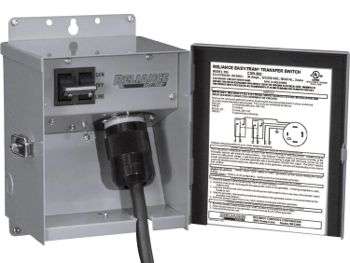Note: I get commissions for purchases made through links in this post.
“Accessories for my portable generator? Doesn’t it come with everything I need?” you may be asking yourself. Unfortunately, we have to answer, “No, it doesn’t.”
Read on to find out what else you really must have and what is just icing on the cake.
That shiny, new portable generator you just bought may include everything you need to get it up and running, but you may also find that there are some important “extras” you never thought of earlier and now realize you really should have.
Let’s take a look at some of the accessories that you can add to your power generation system. Some are must-haves and others are icing on the cake.
What Is a Generator Transfer Switch (and Do I Need One)?
If you intend to use your generator to power your whole house (furnace, etc.), then in a word, yes, you need a generator transfer switch. You can’t just plug your furnace into the generator like you can your refrigerator.
A transfer switch is a device that you (or more likely a licensed electrician) install near and connect to your electrical panel. It handles the source of your power whether city utilities or your portable generator.
When the utilities aren’t working, your generator handles the load and vice versa. It also prevents unwanted back-feed, which sends generator power through non-working power lines (probably being worked on by utility workers) or which sends utility power into your generator.
Are All Transfer Switches the Same?
There are two general categories of transfer switches – manual and power.
A manual transfer switch operates as you would expect, manually. When the power goes out, you have to flip switches as needed.
A power transfer switch does everything for you automatically. You can program it to carry different loads based on your needs.
Either type of switch allows you to own a smaller portable generator because you most likely will only power a few chosen circuits at one time, not the entire house.
Most generator transfer switches have multiple circuits themselves which you can connect to the various loads in your electrical panel (or again more likely instruct your electrician to connect for you).
If you have a manual switch, when it comes time to put it to use, you follow these steps.
- Connect the generator to the switch (or inlet box).
- Make sure all circuit breakers in the switch are turned off.
- Start the generator.
- Flip the main breakers in the switch to Generator.
- Turn on the circuits where you want power.
When the power company has restored normal power, do the following.
- Flip the main breakers in the switch to Utility Power.
- Turn on all circuits in your electrical panel.
- Turn off the portable generator.
- Disconnect the generator from the switch.
More Transfer Switch Differences
Beyond the manual versus power switch option, there are several other considerations when deciding which switch to get.
The wattage varies from 1000W to 12,000W. The voltage can be a combination of 120 and 240 or 120 only. The amperage varies from 15 to 60 and depends on whether you have 120 or 240 volts. You can get a switch that handles from 1 to 12 circuits.
The switch’s power cord can be from 10 to 25 feet long. The switch can come in different enclosures with some being more weatherproof than others.
If you get a transfer switch, you’ll need a power cord to connect it to your generator. These come in amperages from 20 to 50 and in lengths from 10 to 100 feet.
Your choice of these options and the manufacturer will determine the price you have to pay. You may also find that some switches in turn have necessary parts that are sold separately.
What Other Accessories Am I Going to Want?
(Click any of the links below to look for that item at Amazon.)
Fuel Can – Especially if you have a generator that runs on gasoline, which is very likely, you need a source of fuel for it. You may already have a gas can for your lawnmower or snow blower, but it wouldn’t hurt to have one dedicated to your portable generator.
Fuel Stabilizer – It’s entirely possible that you won’t need the gas in that can for a good long time. That would be a good thing. So adding fuel stabilizer to the gas will ensure that the liquid inside is still good even after an extended waiting period.
Power / Extension Cords – If you don’t already own some heavy duty extension cords, you’ll need several of those to connect your appliances and so on to your generator.
Convenience Cables – An alternative to the standard extension cord is a specially designed version often called a convenience cord. It commonly sports four adjacent outlets at one end.
Parallel Cables – If you have two generators you want to connect for double the power, you’ll need cables to connect them in parallel.
Wheel Kit – If your portable generator needs wheels to really be portable but it didn’t come with any, you can probably add them with the purchase of a wheel kit. Just be sure to get the right kit for your model.
Generator Cover – Sometimes you need to store your generator outside when not in use. If so, you might consider a cover for it. Covers come in all sizes, so just look for one that matches the measurements of your machine.
Maintenance Kit – From time to time, your generator will need maintenance. You can get maintenance kits that combine things like air filters, spark plugs, oil filters, cleaning cloths, oil, or touch up paint. Depending on your generator model, you may not need all these items. You can always get the ones you do need separately.
Power Out Alarm – It’s possible that you might not even notice that your power has gone out, if you weren’t using any at the time. An alarm takes care of that problem.
Power Return Alert – Even more difficult to detect is the time your power comes back on, assuming you were using your generator in the mean time. There’s a gadget for that as well.
If you’re into measuring performance, you can can all sorts of meters to assist you. You can get load meters, voltage meters, wattage meters, hour meters, and more.
As I mentioned above, many of these accessories are like icing on the cake; they’re really nice to have but are not absolutely necessary. If you pick those that are must-haves for your particular situation, you can safely ignore the rest.



 A basic transfer switch from Reliance
A basic transfer switch from Reliance